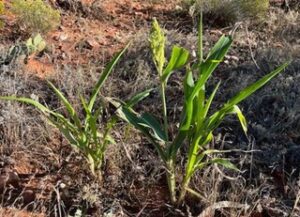
Sorghum is now considered invasive in the Verde Valley region and we can all help stop the invasion. Photo by Jerry Walters, Friends of the Forest.
What is an invasive plant and why is it a problem?
An invasive plant is non-native to the ecosystem under consideration and is likely to cause economic or environmental harm, or harm to human health. Here in the Verde Valley, the Coconino Forest Service has identified the top invasive plants. These include: Salt Cedar, Tree of Heaven, Russian Olive, Giant Reed, Diffuse Knap wood, Star Thistle, Scotch and Bull Thistles, Dalmatian Toadflax, Yellow Bluestem, Johnson Grass, Pampas Grass, Wild Oats, Sahara Mustard, Himalayan Blackberry, and Stink net.
In 2022, a new invasive plant has become widespread in this area: sorghum. Friends of the Forest volunteers Jerry Walters and Dale Evans raised sorghum as a potential issue to the U.S. Forest Service. “The quicker we identify new, non-native, invasive species and remove them, the cheaper it is for the agency, the better it is for native plants and animals, and the more likelihood that we will avoid allowing invasive plants to become so wide-spread as to be cost prohibitive to treat. This has happened with various species, and to a much worse degree in other states,” said Janie Agyagos, Wildlife Biologist, Forest Service, Coconino National Forest.
Sorghum is most often being found on trails near residential areas and is most likely coming from birdseed. The great monsoon precipitation likely caused these seeds to germinate and grow. The more mature seed heads are visible from a distance, but now that it is late in the growing season, the smaller plants are starting to form seed heads that haven’t erupted enough to be seen beyond 10-15 feet.
Friends of the Forest volunteers have pulled over 2,500 sorghum plants from trails. For those who see and want to “treat” these plants, the protocol is to use a small pruning clipper or kitchen scissors to remove the seed head stems and place them in a sealed bag for disposal. After removing the seed head stems, the plant should be pulled and left with its roots exposed to the sun. The plants are easily pulled by grasping firmly at the base and giving a tug. Always proceed with caution when reaching into low limb areas and eye protection of some sort is recommended. If found, please email the location and how many plants were found to Janie.Agyagos@usda.gov.
When planting, native plants provide many benefits and should be used. They have low water requirements, and since water is becoming scarcer, this is an important consideration. Native animals, insects and micro-organisms naturally co-exist with native plants. Besides inquiring at a nursery about what plans are native and non-invasive, here are some suggested substitute plants:
Replace invasive Tree of Heaven with native Arizona Walnut
Replace invasive Giant Reed with Cattail
Replace invasive Dalmatian toadflax with Desert Marigold
Replace invasive Pampas Grass with Bull Grass or Big Sacatan
Replace Himalayan Blackberry with New Mexican Raspberry
Replace Vinca with Desert Four O’clock Mirabili
Replace Russian Olive with Emory Oak
Replace Ivy with Arizona Grape
Replace Primrose with Yellow Monkey Flower
The Red Rock Ranger District and Coconino National Forest are working to treat all kinds of invasive plant species. This work is accomplished by Forest Service staff, volunteers, Verde Watershed Restoration Coalition, and contract crews. Weed species that have been targeted include: a handful of invasive riparian woody species (tamarisk, tree of heaven, Russian olive, and giant reed and an experimental treatment on Himalayan blackberry); and some upland species like bull thistle, scotch thistle, knapweeds, star thistles, dalmatian toadflax, teasel, leafy spurge, English ivy, pampas grass, yellow bluestem grass and Caucasian bluestem grass.
Some invasive species are so established that treatment is cost prohibitive, including Lehmann’s lovegrass, puncture vine, Mediterranean grass, tall fescue grass, filaree, Russian thistle, and others. Newer species that are on the radar to start treating when locations are identified include hedge parsley, onion weed, jointed goat grass, yellow iris, and stinknet. Others that should be treated but are difficult to treat include vinca, Johnson grass, wild oats, and scented night stock.
“We depend on reports from citizens who report unusual plants that suddenly appear on the landscape. Usually, suspicious new plants are non-native invasives. Tackling them early, before they get out of hand, is the key!” said Janie Agyagos
Want more information about Friends of the Forest, or ways to volunteer? Visit www.friendsoftheforestsedona.org.
Serving Sedona, written this week by Carol Dores, Friends of the Forest, appears Wednesday in the Sedona Red Rock News.